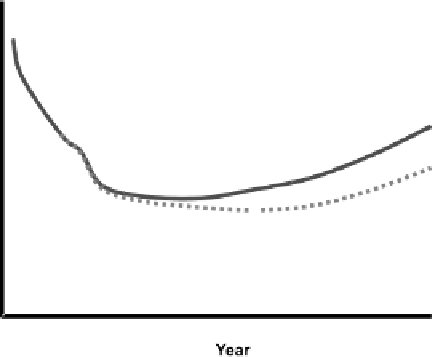Environmental Engineering Reference
In-Depth Information
Source:
Walsh, 2000
Figure 10.2
Noise trends
Fuel efficiency
The fuel consumption of modern aircraft gas turbines is now less than half - per
passenger kilometre - of what it used to be when the Comet was introduced during the
1960s. Over 60 per cent of this saving is due to engine improvements (Rolls-Royce
plc, 1999, p15), as is illustrated in Figure 10.3. Increased engine efficiency comes
from a combination of increased core thermal efficiency (mainly through increased
core temperatures and pressures) and propulsive efficiency (through the use of high
by-pass ratios, defined as the ratio of total air flowing through the engine to the air
flowing through the core).
In addition, changes to aircraft pressurization and air-conditioning systems have
reduced the requirement for engine bleed flow, thus improving engine efficiency. The
aerodynamic efficiency of the airframe has increased through the use of advanced com-
putational fluid dynamics (CFD) and improved wind-tunnel testing techniques. Mod-
ifications to the shape of the engine nacelle inlet section have also reduced drag and
increased efficiency.
One feature that has significantly helped reduced fuel consumption is weight,
with both airframe and engines showing a continued decrease. Lower weight leads
to a lower work requirement for each aircraft mission. For example, a reduction of
1 unit of engine weight can lead to between 1.5 and 4 units of aircraft empty weight
(IPCC, 1999, p229), particularly through reduced structural requirements and
lower fuel volume. The lower power required for take-off means less noise, and the
reduced fuel burn leads to fewer emissions. Today, engines are approximately 30 per
cent lighter than their equivalent ancestors 30 years ago (Beesley, 2000). This has
contributed to an overall reduction in operating empty weight (OEW) per seat of
approximately 50 per cent (Daggett, 2001). These weight reductions have been achieved
by the incorporation, in both the engine and airframe, of lighter and stronger mate-
rials, such as aluminium and titanium alloys, and the use of composites for non-
load-bearing structures.












































































